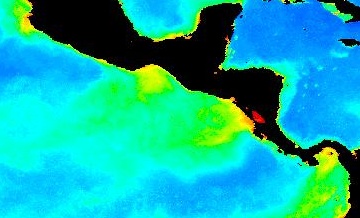Papagayo Jet
[2] The jet winds travel southwest from the Caribbean and the Gulf of Mexico to the Pacific Ocean through a pass in the Cordillera mountains at Lake Nicaragua.
[5] The Papagayo Jet also induces mesoscale meteorology phenomena that influence the pacific waters hundreds of kilometers off the Nicaraguan and Costa Rican shores.
[6] The relatively cold, nutrient-rich waters of the dome, in comparison to the surrounding WHWP, create an ideal habitat for a number of species making the Papagayo Wind Jet important for biodiversity in the Eastern Tropical Pacific.
Air masses repeatedly move in this loop, but due to the Coriolis force, this convection is not perfectly aligned south to north.
In sum, wind speeds in the Papagayo Jet will be high through the months of November to March, peaking in February, then they will be reduced from April to August, and finally diminish completely in September.
[2] The Papagayo Jet winds are strong enough to influence the ocean waters off the west coast of Central America, namely being one of the factors responsible for the Costa Rica Dome.
The waters surrounding the dome (known as the Western Hemisphere Warm Pool) are considerably warmer due to heating from the sun, given the region's proximity to the equator.
As the winds blow southwest over the Pacific they create cyclonic and anticyclonic coastal eddies on the water surface due to Ekman pumping.
Model simulations indicate that without the Papagayo Jet the Costa Rica Dome would not grow to such a large extent and may not even persist year-round.
Indirect evidence of this nutrient transport can be seen in satellite imagery showing increased chlorophyll production in the surface waters directly under the path of the jet.


